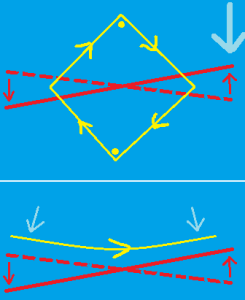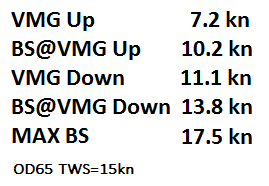Here I’m going to outline the fundamental principles how I tackle WX routing. Honestly my approach is entirely intuition (or software of course), so I don’t have a strict formal way… but the basics are very true.
 Wind shifts
Wind shifts
In the short term, up to maybe 2 days shifts are the primary thing to look for. It helps to visualize a line orthogonal to the wind. As the line moves you need to sail into it… if you are going to tack. The optimum way to tackle shifts will be covered in the VMC topic.
Over a longer time / distance it makes more sense to think of ‘topography’ rather than pure shift.
Rotations
If the wind shift is primarily over space it makes more sense to think of it as a rotation. As mentioned in the last post coastlines induce rotation, the other main sources are high and low pressure systems. Getting closer to the center gives a maximum change in TWD per distance covered, this is normally a good thing. That said, purposely hunting high pressure is out, because…
Windseeking
…to move fast we need strong wind. Period. I tend to prioritize wind speed a lot.
There is the matter of diminishing returns, especially if a boat is limited by hull speed, or any boat upwind, and once in a while extra distance may hurt… But more often than not, go for more power.

Wind direction matters
Beating upwind is slow slow SLOW. As a rule downwind VMG is twice the upwind VMG. And I want to spend as much time as possible at high speeds, TWA100-140 gives the maximum speed depending on the polar.
Cyclones are your friends
This should be a no-brainer. Strong wind, a solid rotation, and they move at a good clip, usually around 20kn. With the big boats you find one and follow it home 
The mid-latitude cyclones that are the bread and butter of most ocean races live between 40 and 60 degrees latitude. As a consequence going beyond 60 degrees is generally not advised.
Seamanship disclaimer
Virtual sailing promotes some unsafe practices, to say the least. When I suggest to drive deep into the center of a storm, I’m looking for the fastest solution in spherical scow land. If you’re navigating a real boat, remember that your boat isn’t big enough, you are lacking elite skills, and you can’t afford the inevitable damage to your boat and crew. In other words – try this at home.
I suggest to revisit the Lisbon – l’Orient stage of the last VOR if you need to know what damage-no-object racing looks like.
OK, that’s it for now. Next time I’ll put it together and route the Capetown – Abu Dabi race.

Great idea of the disclaimer regarding IRL sailing. I take for granted that if there is no disclaimer like this in any other of your excellent articles, there is nothing wrong with implementing SOL techniques for real situations … or are there any contraindications? But seriously, if possible, I would very much appreciate some comments regarding real life vs SOL sailing. BTW, thanks for directing to one of the most exciting videos on youtube from the 11/12 VOR (The Best of Leg 8: Raw Power).
But seriously, if possible, I would very much appreciate some comments regarding real life vs SOL sailing. BTW, thanks for directing to one of the most exciting videos on youtube from the 11/12 VOR (The Best of Leg 8: Raw Power).
Contraindications: Sea state, current, traffic, shallow water, stay away from lee shores, avoid heavy winds etc. And the wx is WRONG on the micro level. We do some stupid stuff in SOL. That VOR leg was monumentally stupid. And so very awesome